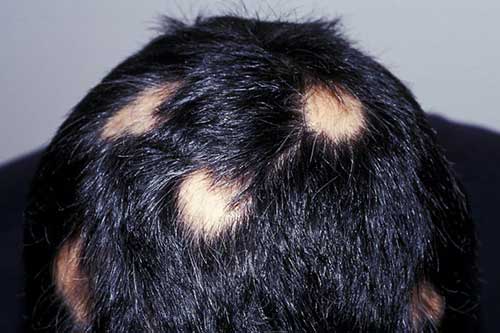First of all, Alopecia Areata is not the result of any actions, deficiencies in your diet or any other lifestyle choice you may have made. It is, in fact, due to your immune system turning against your hair follicles. It affects about one person in 1,000 and mostly strikes before the age of 30.
Alopecia Areata is thought to be an auto-immune disorder in which the immune system attacks and damages the hair follicles. This causes the hair to fall out, leaving coin-size patches of hair loss on the scalp, but also on the face and other areas of the body.

Quite why the immune system should behave in this way is unclear, but genetic factors are implicated, and 20 per cent of patients have a close relative with the condition.
In a small number of people —around one in five — the hair loss progresses further. It can involve the entire scalp, which is alopecia totalis, or all the body hair can be lost, including the eyelashes and eyebrows; this is called alopecia universalis. This is more likely if the patient also suffers atopic eczema or if more than half of the scalp is affected by the initial hair loss.
In most patients with alopecia areata, the condition spontaneously improves, usually within a year, but relapse is common. In terms of medical treatment, there are a few options, though their effectiveness varies with the individual.
One option for the disc-like patches of baldness is injections of the steroid cortisone into each patch, which can help to dampen down the inflammation caused by the immune system attack, responsible for destroying hair follicles. If the hair loss is widespread, then cortisone injections may not be a realistic prospect.
Another option is a solution of Minoxidil, available from chemists, which can be added to the treatment plan if response to the steroid injection is poor. Results achieved with Minoxidil can vary however.
Immunotherapy may be helpful. Here, a powerful chemical irritant is placed on the patches of hair loss. The most commonly used substance is diphencyprone, and over a number of weeks an increasingly high strength of this chemical is used, which eventually initiates an allergic reaction, and the skin will develop eczema. The resultant reaction is associated with a return of hair growth, though why this works is unknown. Half of patients respond favourably and see the return of hair. This highly specialised treatment is carried out by a dermatologist.
Obviously the MHT technique can help greatly, not with combating the symptoms of Alopecia Areata, but in camouflaging its effects. For more information, see our Alopecia Treatment page.
Medical practitioners are generally sympathetic about the emotional distress this condition can cause, therefore a suitably qualified individual may be able to provide the best advice.
